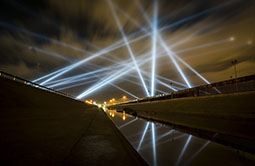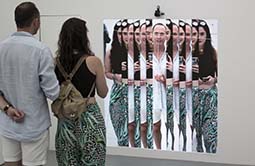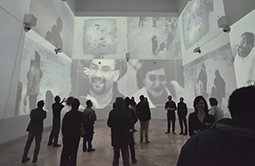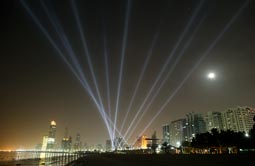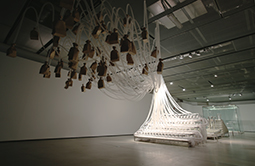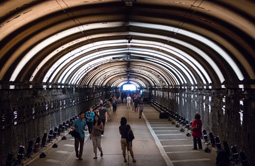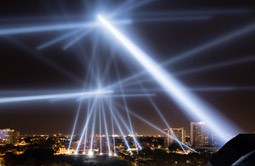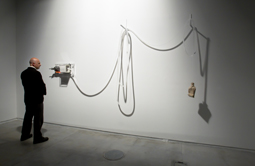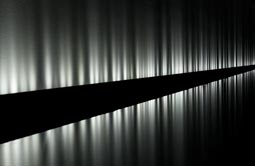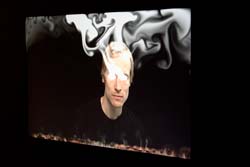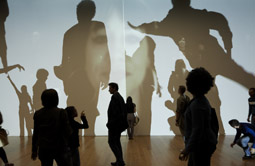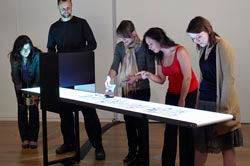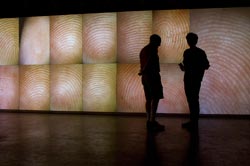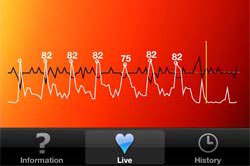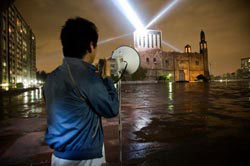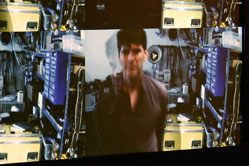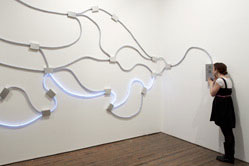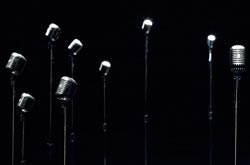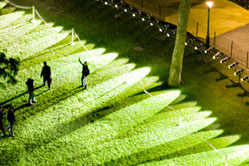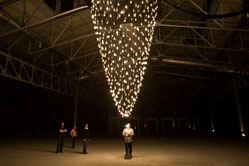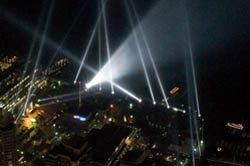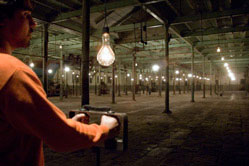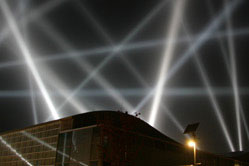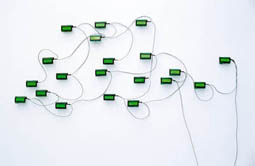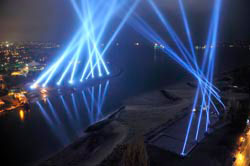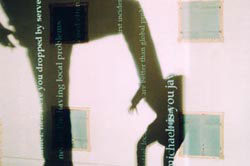Border Tuner / Sintonizador Fronterizo
Relational Architecture 23, 2019
"Border Tuner" is a large-scale, participatory art installation designed to interconnect the cities of El Paso, Texas, and Ciudad Juárez, Chihuahua. Powerful searchlights make “bridges of light” that open live sound channels for communication across the US-Mexico border. The piece creates a fluid canopy of light that can be modified by visitors to six interactive stations, three placed in El Paso and three in Juárez.
View details.
View details.
Bilateral Time Slicer
2016
“Bilateral Time Slicer” is a biometric tracking system that finds the axis of symmetry of members of the public and splits a live camera image into two slices. With each new participant time slices are recorded and pushed aside. When no one is viewing the work, the slices close and rejoin creating a procession of past recordings.
View details.
View details.
Zoom Pavilion
2015
“Zoom Pavilion” is an interactive installation that consists of immersive projection on three walls, fed by 12 computerized surveillance systems trained on the public. The piece uses face recognition algorithms to detect the presence of participants and record their spatial relationship within the exhibition space. Independent robotic cameras zoom in to amplify the images of the public with up to 35x magnification: the zooming sequences are disorienting as they change the entire image "landscape" from easily recognizable wide shots of the crowd to abstract close-ups. Zoom Pavilion marks the first collaboration between artists Rafael Lozano-Hemmer and Krzysztof Wodiczko.
View details.
View details.
Pulse Corniche
Relational Architecture 22, 2015
“Pulse Corniche” (Relational Architecture 22) was an interactive canopy of powerful light beams projected into to the sky by robotic searchlights whose brightness and orientation was controlled by the heart-rate of visitors to the Abu Dhabi’s Corniche. People were free to participate by holding a sensor placed in the centre of the plaza that converted the electrical activity of their heart into a unique lighting sequence. The intensity and direction of the lights visualized the different biometric rhythms of each participant, in an urban scale.
View details.
View details.
Vicious Circular Breathing
2013
“Vicious Circular Breathing” is a hermetically-sealed apparatus that invites the public to breathe the air that was previously breathed by participants before them. The installation consists of a glass room with double sliding doors, two emergency exits, carbon dioxide and oxygen sensors, a set of motorized bellows, an electromagnetic valve system, and 61 brown paper bags hanging from respiration tubes. In the piece, visitors’ breath is kept circulating and made visible by automatically inflating and deflating the brown paper bags around 10,000 times a day, the normal respiratory frequency for an adult at rest. The piece includes warnings for asphyxiation, contagion and panic, and produces a faint mechanical sound, a quiet whir from the air flow and louder crackles from the crumpling bags.
View details.
View details.
Voice Tunnel
Relational Architecture 21, 2013
“Voice Tunnel” (Relational Architecture 21) was an installation designed to transform the Park Avenue Tunnel in New York City with 300 theatrical spotlights that produce glimmering arches of light along the tunnel’s walls and ceiling. Participants control the intensity of each light by speaking into an intercom at the tunnel’s center which records their voice and loops it. Louder speech increases the lights’ brightness proportionally, creating a Morse-like code of flashes throughout the tunnel. The individual voices can be heard as pedestrians walk through the tunnel, on 150 loudspeakers, one beside each light arch and synchronized with it. At any given time, the tunnel is illuminated by the voices of the past 75 participants: as new participants speak into the intercom, older recordings get pushed away by one position down the array of light fixtures until they leave the tunnel, so that the content of the piece is changing constantly.
View details.
View details.
Open Air
Relational Architecture 19, 2012
“Open Air” (Relational Architecture 19) was an interactive artwork that allowed participants’ voices to transform the sky over Philadelphia. Using a website or a free iPhone app participants could record a voice message and listen to and rate other entries. The messages were played-back over the Benjamin Franklin Parkway using 24 powerful robotic searchlights that reacted, both in brightness and position, to the voice’s frequency and volume as well as to the phone's GPS location.
View details.
View details.
Last Breath
2012
“Last Breath” is an installation designed to store and circulate the breath of a person forever. The piece consists of a small brown paper bag which inflates and deflates automatically thanks to motorized bellows similar to those found in artificial respirators in hospitals. The apparatus hangs on a wall and is activated 10,000 times a day, the typical respiratory frequency for an adult at rest, including 158 sighs.
View details.
View details.
Voice Array
Subsculpture 13, 2011
In “Voice Array” (Subsculpture 13), as a participant speaks into an intercom, his or her voice is automatically translated into flashes of light and then the unique blinking pattern is stored as a loop in the first light of the array. Each new recording pushes all previous recordings one position down and gradually one can hear the cumulative sound of the 288 previous recordings. The voice that was pushed out of the array can then be heard by itself.
View details.
View details.
The Year's Midnight
2011
"The Year's Midnight" is an interactive installation that shows the viewers' image on screen, unprocessed, except for plumes of white or black smoke that emanate from their eye sockets until the whole display is filled with a dense smog. Live and recorded eyeballs extracted from the video accumulate on the bottom of the display, similar to traditional representations of St. Lucy. The project's name is the beginning of John Donne's "A Nocturnal Upon St. Lucy's Day, Being the Shortest Day", a mournful poem which inspires this work.
View details.
View details.
People on People
2010
“People on People” is an installation designed to displace the public’s image in real-time, creating a platform for embodiment and interpenetration. The piece consists of floor-mounted projectors that cast the shadow of the public onto a wall and another set of hanging projectors which project images inside the shadows.
View details.
View details.
Please Empty Your Pockets
Subsculpture 12, 2010
“Please Empty your Pockets” (Subsculpture 12) is an installation that consists of a conveyor belt with a scanner that records and accumulates everything that passes under it. The public may place any small object on the conveyor belt: once it passes under the scanner, the object reappears on the other side beside projected objects from the memory of the installation. As a real item is removed from the conveyor belt, it leaves behind a projected image of itself, which is then used to accompany future objects. The piece remembers up to 600,000 objects which are displayed beside new ones that are added to the installation.
View details.
View details.
Pulse Index
2010
"Pulse Index" is an interactive installation that records participants’ fingerprints at the same time as their heart rates. The piece displays data for the last 765 and over participants in a stepped display that creates a horizon line of skin. As new recordings are added, the oldest ones disappear, —a kind of memento mori. To participate, people introduce their finger into a custom-made sensor equipped with a digital microscope and a heart rate sensor; their fingerprint immediately appears on the largest cell of the display, pulsating to their heart beat.
View details.
View details.
Nothing is More Optimistic than Stjärnsund
2010
“Nothing is More Optimistic than Stjärnsund” consists of twenty modified padlocks which can be interconnected to create chains or assemblages, as the collector or curator sees fit. The piece is intended as a construction kit with a plethora of possible combinations, like a Meccanno, and is a hommage to Lygia Clark's "Relational Objects”.
View details.
View details.
Pulse Phone
2009
“Pulse Phone” is an application that measures your heart rate by using the iPhone's built-in camera and flash. The application detects small variations in the opacity of your finger as blood flows through it and calculates your pulse in beats per minute using this information. The app visualizes the data graphically and can store it for later reference.
View details.
View details.
Voz Alta
Relational Architecture 15, 2008
"Voz Alta" (Loud Voice)(Relational Architecture 15) is a memorial commissioned for the 40th anniversary of the student massacre in Tlatelolco. Participants who speak into a megaphone automatically control the brightness of four searchlights that relay their voice over Mexico City as quiet light flashes; tuning into 96.1FM radio allows people anywhere in the city to listen in live to what the lights are saying.
View details.
View details.
Alpha Blend
Shadow Box 7, 2008
"Alpha Blend" (Shadow Box 7) is an interactive display with a built-in computerized tracking system that show the viewer's presence, revealing and blending pictures of people who have previously looked at the work. A game of "reverse puppetry" ensues, where a portrait from the past is animated by a live presence, in a similar perceptual mechanism than the one used in Lozano-Hemmer's public art installation "Body Movies" (2001).
View details.
View details.
Less Than Three
2008
"Less than Three" is an interactive installation of light strips that form a network between two intercoms. As a participant speaks into an intercom, their voice is translated into corresponding flashes of light and this light pattern is transmitted visually along one of the several possible pathways through the network. When it reaches the other side, the viewer's phrase is once again released as sound. Several voices can be carried simultaneously and the short contributions going fast through the network and the longer ones taking longer.
View details.
View details.
Microphones
Subsculpture 10, 2008
"Microphones" (Subsculpture 10) is an interactive installation featuring one or several 1939-vintage Shure microphones, placed on mic stands around the exhibition room at different heights. Each microphone has been modified so that inside its head is a tiny loudspeaker and a circuit board connected to a network of hidden control computers. When a public member speaks into a microphone, it records his or her voice and immediately plays back the voice of a previous participant, as an echo from the past.
View details.
View details.
Pulse Park
Relational Architecture 14, 2008
"Pulse Park" (Relational Architecture 14) is comprised of a matrix of light beams that grazed the central oval field of Madison Square Park, New York City. The intensity of each spotlight is entirely modulated by a sensor that measures the heart rate of participants. The resulting effect is a visualization of the body's vital signs, arguably our most symbolic biometric, at an immense scale and in an urban setting.
View details.
View details.
Pulse Spiral
2008
"Pulse Spiral" is a three-dimensional spiral paraboloid made up of 400 lightbulbs arranged according to Fermat's equations, which records and responds to the heart rate of participants who hold a sensor underneath. Commissioned for the opening of the Center for Contemporary Culture in Moscow in the constructivist Bakhmetevsky Bus Garage, the piece is inspired by engineer Vladimir Shukov who worked with Melnikov on this emblematic building from 1926-28.
View details.
View details.
Pulse Front
Relational Architecture 12, 2007
"Pulse Front" (Relational Architecture 12) was an interactive light installation over Toronto's Harbourfront Centre, consisting of a matrix of light beams from twenty powerful robotic searchlights controlled by a network of sensors that measured the heart rate of passers-by. Ten metal sculptures detected and measured the pulse of people who held them and their readings were immediately converted into light pulses and also determined the orientation of the beams.
View details.
View details.
Close-up
Shadow Box 3, 2006
"Close-up", the third piece of the ShadowBox series, is an interactive piece in which a participant's silhouette reveals hundreds of tiny videos of other people who have previously looked at the work. When a viewer approaches the piece, the system automatically starts recording and makes a video of him or her. Simultaneously, inside the viewer's silhouette, videos are triggered, showing up to 800 recent recordings. This piece presents a schizoid experience where one’s presence triggers a massive array of surveillance videos.
View details.
View details.
Pulse Room
2006
"Pulse Room" is an interactive installation featuring one to three hundred clear incandescent light bulbs, 300 W each and hung from a cable at a height of three metres. The bulbs are uniformly distributed over the exhibition room, filling it completely. An interface placed on a side of the room has a sensor that detects the heart rate of participants. When someone holds the interface, a computer detects his or her pulse and immediately sets off the closest bulb to flash at the exact rhythm of his or her heart.
View details.
View details.
Amodal Suspension
Relational Architecture 8, 2003
“Amodal Suspension" (Relational Architecture 8) is a large-scale interactive installation in which people send short text messages to each other using a cell phone or web browser. However, rather than being sent directly, the messages are encoded as unique sequences of flashes with twenty robotically-controlled searchlights, not unlike the patterns that make up Morse code. Messages "bounce" around from searchlight to searchlight, turning the sky into a giant switchboard.
View details.
View details.
33 Questions per Minute
Relational Architecture 5, 2000
"33 Questions Per Minute" (Relational Architecture 5) consists of a computer program which uses grammatical rules to combine words from a dictionary and generate 4.7 trillion unique, fortuitous questions. The automated questions are presented at a rate of 33 per minute—the threshold of legibility. The system will take over 271,000 years to ask all possible questions.
View details.
View details.
Vectorial Elevation
Relational Architecture 4, 1999
"Vectorial Elevation" (Relational Architecture 4) is an interactive art project originally designed to celebrate the arrival of the year 2000 in Mexico City's Zócalo Square. The website www.alzado.net enabled any Internet user to design light sculptures over the city's historic centre, with eighteen searchlights positioned around the square. These searchlights, whose powerful beams could be seen within a 15 kilometers radius, were controlled by an online 3D simulation program and visualised by digital cameras. A personalised webpage was produced for every participant with images of their design and information such as their name, dedication, place of access and comments.
View details.
View details.
Re:Positioning Fear
Relational Architecture 3, 1997
"Re:Positioning Fear" (Relational Architecture 3) was a large-scale installation on the Landeszeughaus military arsenal with a "teleabsence" interface of projected shadows of passers-by. Using tracking systems, the shadows were automatically focused and generated sounds. A real-time IRC discussion about the transformation of the concept of "fear" was projected inside the shadows; the chat involved 30 artists and theorists from 17 countries.
View details.
View details.
